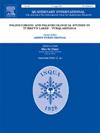Was LIA synchronous with equa-tropical climate? A multiproxy study from the southwest coast of India
IF 1.9
3区 地球科学
Q3 GEOGRAPHY, PHYSICAL
引用次数: 0
Abstract
A comprehensive study of the Mundrothruthu (MT) core (70 cm) from the Asthamudi wetland in Kollam, Kerala, India reveals three climate phases during the Little Ice Age (LIA) through multi-proxy investigations. The period (1507–1518 CE) shows high agricultural activity indicated by abundant diatom diversity, significant terrestrial influx, and freshwater runoff. Elevated TOC% and δ13CTOC values suggest high temperature and a warm, humid climate, likely driven by high terrestrial influx and transport of organic matter from the nearby surroundings. This may have increased the organic matter influx to the estuary leading to high TOC% and more negative δ1³C values. The second phase (1519–1548 CE) is characterized by increased marine incursion due to enhanced tidal currents, evidenced by a rise in marine palynomorphs, mixed terrestrial and marine organic matter, less negative δ13C values, and increased mud content. This shift likely reflects changes in sea level or tidal dynamics. The final period (1548–1804 CE) is marked by further enhancement of marine taxa, lower TOC%, and δ13CTOC values, indicating reduced atmospheric CO2 and a temperature decrease of about 1 °C. This period is associated with reduced solar insolation and a southward shift of the Inter Tropical Convergence Zone (ITCZ). The study highlights both synchronous and asynchronous climatic behavior on the southwest coast of India relative to global changes during the LIA. Initially warm and humid with high agricultural productivity, the region gradually shifted to marine-dominated conditions due to tidal dynamics and broader climatic shifts. These findings underscore the complex interplay between local and global climatic factors during the LIA.
晚霞与等热带气候同步吗?印度西南海岸的多代理研究
对印度喀拉拉邦科拉姆 Asthamudi 湿地的 Mundrothruthu(MT)岩心(70 厘米)的综合研究通过多代理研究揭示了小冰河时期(LIA)的三个气候阶段。这一时期(西元 1507-1518 年)农业活动频繁,硅藻种类丰富,大量陆地生物涌入,淡水径流。TOC% 和 δ13CTOC 值的升高表明当时气温较高,气候温暖湿润,这很可能是由于大量陆地有机物从附近环境流入和迁移造成的。这可能增加了流入河口的有机物,导致高 TOC%和更多的δ1³C 负值。第二阶段(公元 1519-1548 年)的特点是,潮汐流增强导致海洋入侵增加,表现为海洋古动物、陆地和海洋混合有机质增加,δ13C 负值降低,泥浆含量增加。这一转变可能反映了海平面或潮汐动力学的变化。最后一个时期(公元 1548-1804 年)的特点是海洋类群进一步增加,TOC% 和 δ13CTOC 值降低,表明大气中的 CO2 减少,温度下降约 1 ℃。这一时期与太阳日照减少和热带辐合带(ITCZ)南移有关。该研究强调了印度西南海岸在大裂谷时期相对于全球变化的同步和非同步气候行为。该地区最初温暖潮湿,农业生产率较高,后来由于潮汐动力学和更广泛的气候变迁,逐渐转变为以海洋为主的条件。这些发现凸显了大裂谷时期当地与全球气候因素之间复杂的相互作用。
本文章由计算机程序翻译,如有差异,请以英文原文为准。
求助全文
约1分钟内获得全文
求助全文
来源期刊

Quaternary International
地学-地球科学综合
CiteScore
5.60
自引率
4.50%
发文量
336
审稿时长
3 months
期刊介绍:
Quaternary International is the official journal of the International Union for Quaternary Research. The objectives are to publish a high quality scientific journal under the auspices of the premier Quaternary association that reflects the interdisciplinary nature of INQUA and records recent advances in Quaternary science that appeal to a wide audience.
This series will encompass all the full spectrum of the physical and natural sciences that are commonly employed in solving Quaternary problems. The policy is to publish peer refereed collected research papers from symposia, workshops and meetings sponsored by INQUA. In addition, other organizations may request publication of their collected works pertaining to the Quaternary.
 求助内容:
求助内容: 应助结果提醒方式:
应助结果提醒方式:


